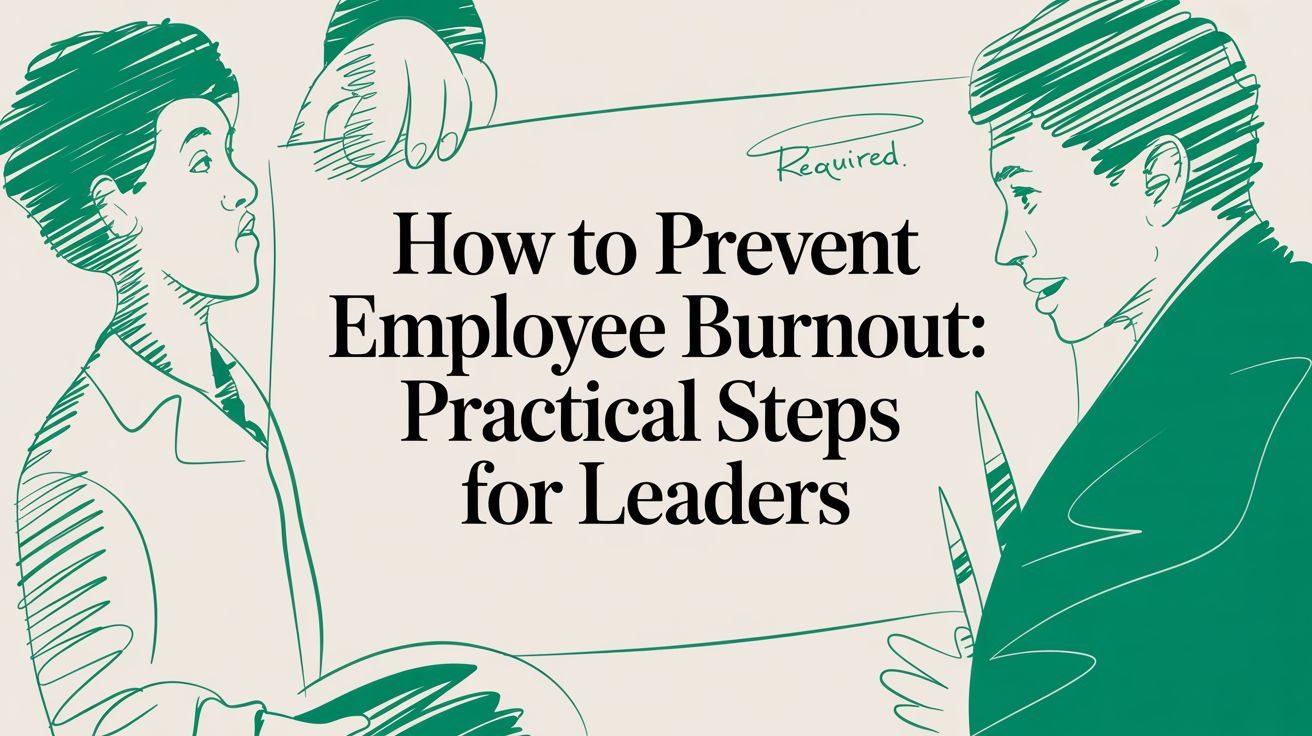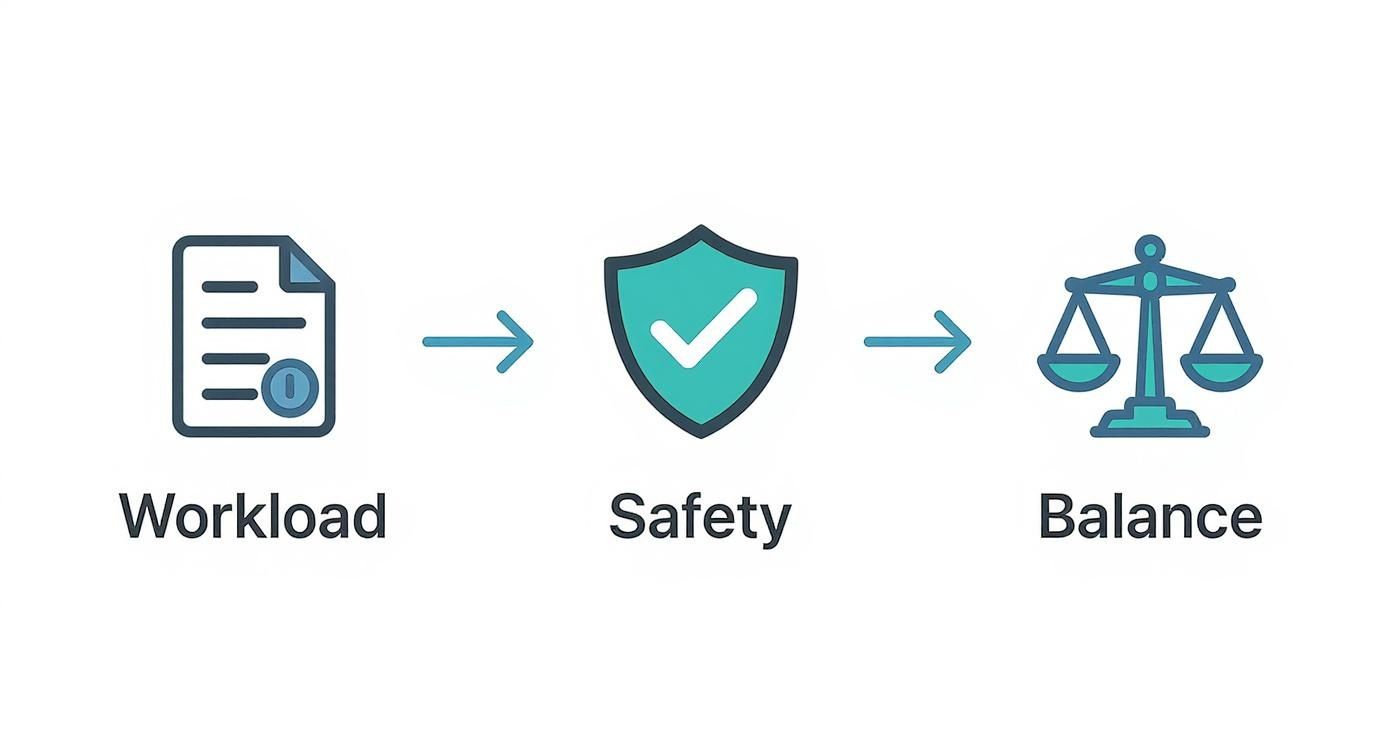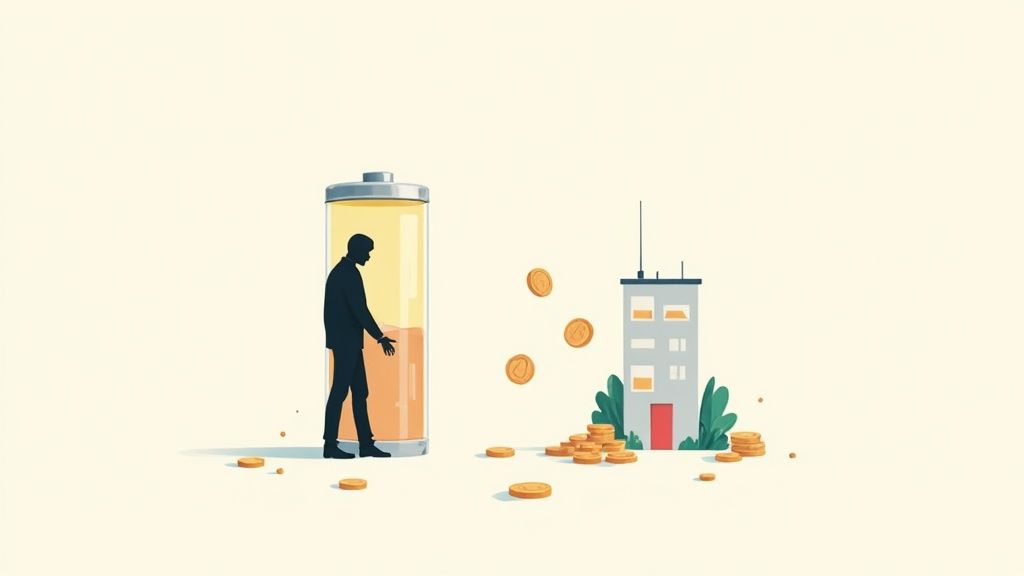how to prevent employee burnout: Practical Steps for Leaders

If you want to get serious about preventing employee burnout, you need to focus on three core areas: creating sustainable workloads, fostering a culture of genuine psychological safety, and actually championing work-life balance (not just talking about it). When leaders nail these, they shift from a reactive, fire-fighting mode to proactively building a workplace where people can truly thrive.
The Hidden Costs of Employee Burnout
Let's be clear: ignoring burnout isn't just a morale problem. It's a direct threat to your bottom line. Too many leaders write it off as temporary stress, but the reality is that it's a slow, corrosive force that quietly eats away at productivity, bloats your costs, and can poison your company culture for years. This isn't about an employee's personal failing; it's an organizational problem with serious financial consequences.
When exhaustion becomes the baseline, the effects start to ripple through the entire company, creating a vicious cycle of inefficiency and disengagement that's incredibly hard to escape.
Beyond Obvious Productivity Loss
The first thing you'll notice is a nosedive in productivity. Burned-out employees aren't just tired—they become cynical and disconnected from their work, which leads to missed deadlines and a drop in quality. But the financial drain goes much deeper than that.
The World Health Organization now officially recognizes burnout as an "occupational phenomenon," which should be a massive wake-up call for companies everywhere. The cost of doing nothing is staggering. In the United States alone, burnout is estimated to cost up to $322 billion annually in lost productivity. These aren't small numbers; they make a compelling case for getting ahead of the problem. You can find more details in the full research on burnout's economic impact.
Burnout isn't the price of success. It's the cost of a broken system. When an organization fails to manage workloads and protect its people, it erodes its most valuable asset.
This is why a simple, three-part approach focusing on workload, safety, and balance is so effective.

As the visual shows, you have to tackle this from multiple angles. It all starts with manageable workloads, but that effort needs to be supported by an environment that feels safe and allows for real balance.
Here’s a summary of the core strategies for preventing burnout, giving you a quick overview of the solutions we'll cover in this guide.
A Quick Look at Burnout Prevention Pillars
| Prevention Pillar | Key Action | Primary Goal |
|---|---|---|
| Sustainable Workload Management | Assess and right-size workloads; set clear priorities. | Eliminate chronic overload and reduce constant pressure. |
| Psychological Safety | Foster open communication and build manager support. | Create an environment where people feel safe to speak up. |
| Work-Life Balance | Implement flexible policies and respect personal time. | Help employees recharge and separate work from their lives. |
Each of these pillars is crucial for building a resilient team that can perform sustainably over the long haul.
The True Price of Turnover and Toxicity
High turnover is another huge, often underestimated, expense. It's no surprise that employees on the brink of burnout are far more likely to be polishing their resumes and actively looking for an exit. That leaves you holding the bag for recruitment fees, training costs for new hires, and the loss of institutional knowledge.
Worse yet, burnout is a key ingredient in a toxic work environment. Cynicism and negativity are contagious. They spread quickly from one overwhelmed team member to the next, chipping away at trust and collaboration until it's nearly impossible for anyone to do their best work. Things like unfairness—whether in how work is handed out or how people are paid—act like gasoline on the fire. Understanding what pay transparency is and putting it into practice can be a powerful move to rebuild trust and show a real commitment to fairness.
Ultimately, the real cost of employee burnout is paid in lost innovation, evaporating loyalty, and a tarnished employer brand. The strategies in this guide aren't just "nice-to-haves"—they are non-negotiable for any company that's serious about lasting success.
How to Spot the Early Warning Signs of Burnout

You can't fix a problem you can't see. The real secret to preventing employee burnout isn't some grand initiative; it's catching the issue before it spirals into a full-blown crisis. By the time an employee is completely checked out, the damage is already done.
The earliest indicators are almost always subtle shifts in behavior, not dramatic meltdowns. It's easy to write them off as just a bad week, but when these small changes start forming a consistent pattern, it’s a sign that something much deeper is wrong. Learning to spot these cues is your chance to step in with support when it can actually make a difference.
From Engagement to Exhaustion
One of the first and most obvious signs of burnout is a clear shift from normal engagement to chronic exhaustion. This isn't just about being tired after a long day. It’s a profound, persistent sense of being physically and emotionally drained. With research showing that nearly three-quarters of employees feel burned out at some point, this exhaustion is usually the first domino to fall.
Keep an eye out for team members who always seem to be running on empty. They might mention not sleeping well, seem distracted in meetings, or struggle to focus on tasks they used to handle easily.
The real danger here is that exhaustion creates a vicious cycle. The stress from work disrupts their sleep, which leads to more fatigue the next day, which then makes it even harder to cope with their workload.
Think of your star project manager who's suddenly missing deadlines. They seem to be online late every night, but their output is decreasing and their thinking seems muddled on team calls. This isn't a performance issue; it’s a capacity issue.
The Rise of Cynicism and Detachment
When chronic exhaustion takes hold, cynicism is never far behind. People start to feel mentally distant from their jobs, looking at their work, their colleagues, and even the company's mission with a growing sense of negativity. It’s not just a "bad attitude"—it’s a psychological shield against feeling overwhelmed and unappreciated.
This kind of detachment shows up in a few key ways:
- Growing Irritability: Little things that used to be no big deal now trigger a visibly frustrated or annoyed response.
- Loss of Enthusiasm: Someone who used to be full of ideas in brainstorming sessions now stays quiet or only gives minimal, one-word answers.
- Apathy Towards Results: They seem completely indifferent to whether a project succeeds or fails, showing a clear lack of investment in the outcome.
Imagine a senior designer who was once the team’s biggest cheerleader. Now, they're making sarcastic jabs about new company initiatives and seem to have lost all passion for their creative work. This isn't just a mood swing; it’s a bright red flag for burnout.
Recognizing burnout isn't about looking for one single sign. It's about identifying a pattern of change—a shift from an employee's normal baseline of behavior to one of consistent negativity, exhaustion, and withdrawal.
This pattern is your cue to start a conversation, not a performance review.
A Drop in Professional Efficacy
The final piece of the burnout puzzle is a creeping sense of inefficacy—the feeling that nothing you do matters or makes a difference. Employees begin to doubt their own skills and feel incompetent, even if their actual performance hasn't tanked just yet.
This is often the direct result of an unmanageable workload or a workplace culture of constant interruptions. When someone is perpetually underwater and can't find time to focus, their productivity naturally suffers. This fuels a crippling belief that they’re failing, no matter how many hours they put in.
Here's what to watch for:
- Procrastination: They start putting off complex tasks that they once tackled head-on.
- Missed Deadlines: They are consistently falling behind on assignments, even smaller ones.
- Avoiding Collaboration: They pull back from team projects or even casual social interactions with colleagues.
For example, a top-performing marketer suddenly starts avoiding the lead role on new campaigns. They express self-doubt in one-on-ones and seem overwhelmed by their to-do list, despite handling similar workloads in the past. This feeling of being ineffective is a classic sign that their resilience is worn thin.
By learning to spot these three interconnected signs—exhaustion, cynicism, and inefficacy—you can shift from just reacting to crises to proactively building a workplace where people can thrive.
Building a Culture That Fights Burnout

Let's be honest: free snacks and a ping-pong table aren't going to solve a burnout crisis. Those are surface-level perks that do very little to address the real, grinding causes of employee exhaustion.
If you’re serious about preventing burnout, you have to go deeper. It's about weaving well-being into the very fabric of your company culture. This isn’t a quick fix; it’s a fundamental shift from reacting to problems to proactively creating a system where sustainable work is just how things are done.
A truly supportive culture is built on trust, respects boundaries, and has leaders who don't just talk about balance but actually live it. The goal is to create an environment where high performance and good health are seen as partners, not competitors.
Foster Genuine Psychological Safety
The absolute foundation of an anti-burnout culture is psychological safety. It's that shared belief in a team that you can speak up—with a new idea, a tough question, a concern, or even a mistake—without fearing you'll be punished or humiliated.
In the context of burnout, it’s the difference between an employee saying, "I'm drowning in my workload," and being met with support versus judgment. Without that safety net, people just suffer in silence, convinced that admitting they're struggling is a sign of weakness. That silence is a direct path to exhaustion.
Building a resilient team requires a real commitment, including adopting comprehensive strategies to reduce employee burnout.
Here’s how managers can start building that safety:
- Normalize vulnerability. When leaders openly share their own struggles or admit they don’t have an answer, it gives everyone else permission to be human, too.
- Respond with curiosity, not criticism. If someone flags a tight deadline as a problem, don't question their commitment. Instead, ask, "What part of this feels most overwhelming? Let's look at it together."
- Encourage constructive dissent. Actively ask for different viewpoints in meetings. When someone challenges an idea, thank them for it. This reinforces that every voice matters.
Lead by Example with Healthy Work Habits
Your team is always watching. They look to their leaders for cues on how to behave. If you're consistently sending emails at 10 PM, the unspoken message is that everyone should be on-call around the clock.
This is why leaders must visibly and consistently model the healthy habits they want to see.
A marketing director who loudly announces she's offline for a full hour to eat lunch does more to prevent burnout than a dozen "wellness Wednesday" emails ever could. A VP who shares that they're taking a mental health day helps kill the stigma around needing to rest and recharge.
Leaders who prioritize their own well-being are not being selfish; they are creating a permission structure for their entire team to do the same. Rest is not the enemy of productivity—it’s a vital ingredient.
These actions prove that the company’s commitment to work-life balance is real, not just a poster on the wall. This kind of authentic leadership is a huge driver of engagement, which naturally leads to a more satisfied team. For more on this connection, there are plenty of proven ways to increase employee satisfaction that align with building this kind of culture.
Establish and Protect Clear Boundaries
In our hyper-connected world, the line between work and home life has become dangerously blurry. A culture that truly fights burnout has to actively build—and defend—clear boundaries that protect people's personal time.
This can’t be left to individual employees to figure out. It demands clear, company-wide policies that are enforced from the top down.
For instance, a marketing agency could implement "Deep Work Wednesdays," a four-hour block every week with a strict no-meetings rule. This gives creatives, strategists, and analysts the uninterrupted time they need to tackle complex work, cutting down on the fragmented, frustrating tasks that fuel burnout.
Here are a few other practical boundaries you can set:
- Communication Charters: A simple guide outlining which channel to use for what. (e.g., Slack for quick questions, email for non-urgent follow-ups, phone calls for actual emergencies).
- After-Hours Expectations: A formal policy stating that no one is expected to answer emails or messages outside of their working hours, unless it's a true crisis.
- Meeting-Free Days: Block off one day a week, like Friday, from all internal meetings. This simple change can drastically reduce calendar clutter and give your team back precious focus time.
By putting these guardrails in place, you shift the responsibility for preventing burnout from the individual to the organization. That systemic approach is the only way to create lasting change and build a workplace where your team can truly thrive.
Practical Strategies for Managers to Support Their Teams
While company culture sets the overall tone, managers are the ones in the trenches with their teams every single day. They are your first, and best, line of defense against burnout. A manager's actions can either pour gasoline on workplace stress or create a powerful buffer against it.
This isn't about piling more onto a manager's already-full plate. It’s about arming them with simple, practical ways to turn daily interactions into real support for their team's well-being. By focusing on these tangible strategies, leaders get the tools they need to stop burnout before it even starts.
Transform One-on-Ones into Well-Being Check-Ins
Far too many one-on-one meetings become little more than status updates or to-do list reviews. That's a huge missed opportunity. These recurring conversations should be your primary way of getting a real pulse on an employee's workload, stress levels, and overall experience.
Instead of kicking things off with, "What's the status of the campaign?" try asking questions that open the door to a real conversation. This small shift can completely change the dynamic.
- "What’s taking up most of your energy this week, both good and bad?"
- "Are there any blockers right now that are making your work more frustrating than it needs to be?"
- "On a scale of 1 to 10, how is your workload feeling right now?"
Questions like these invite an honest discussion about well-being without feeling like an interrogation. When a manager truly listens to the answers and offers genuine support, they build the psychological safety people need to admit they're struggling. This is proactive leadership, especially when you consider that nearly half (45%) of burned-out employees are actively looking for a new job.
Actively Protect Your Team's Focus
In today’s always-on work culture, one of a manager’s most important jobs is to play defense. That means protecting their team from the endless barrage of unnecessary meetings, context switching, and low-value interruptions that make people feel completely ineffective.
A manager who consistently cancels non-essential meetings or declines them on behalf of their team is a hero. They are giving their people back their most valuable resource: time to do meaningful work.
This requires being intentional about how the team’s time is structured. For a marketing team, maybe that means blocking off "no-meeting" afternoons so writers and designers can actually get into a creative flow. It could also involve setting up a clear communication guide that defines what’s worthy of an urgent Slack message versus what can wait in an email.
By setting and enforcing these boundaries, managers directly fight one of the biggest drivers of burnout—that awful feeling of being constantly busy but never actually productive. These efforts are also fundamental to the best employee retention strategies, as they show a tangible respect for an individual's time and contribution.
Distribute Workloads with Equity and Clarity
Unfair treatment and an impossible workload are two of the fastest tracks to burnout. Managers are on the hook for ensuring work is distributed not just evenly, but equitably. This means taking into account each person's current capacity, their unique skills, and even their career development goals.
It's not about giving everyone the exact same amount of work. It’s about assigning the right work to the right person at the right time.
Here's a Real-World Scenario
Imagine a new product launch is on the horizon. Instead of just slinging tasks as they pop up, a smart manager could:
- Map out every required task for the entire launch campaign.
- Hold a quick team huddle to talk about capacity, pointing out who's just wrapping a major project and who has more bandwidth.
- Assign tasks based on that conversation, making sure the person with deep analytics skills isn't stuck doing administrative scheduling.
This kind of transparent process heads off any perception of favoritism and ensures no single person is constantly shouldering the heaviest load. It transforms workload management from a reactive guessing game into a proactive, collaborative effort.
Make Meaningful Recognition a Consistent Habit
A core element of burnout is feeling like your work just doesn't matter. Consistent, meaningful recognition is the perfect antidote. It reinforces an employee’s value and connects their day-to-day efforts to the bigger picture.
This goes way beyond an annual bonus or a company-wide award. The most powerful recognition is often small, specific, and delivered right in the moment.
- Public Praise: "In our team meeting, I want to give a huge shout-out to Sarah. The customer insight she pulled from that data was the key to our new ad campaign. Incredible work."
- Peer-to-Peer Recognition: A dedicated Slack channel where team members can thank each other is a fantastic way to build a supportive community.
- Private Acknowledgment: A simple, direct message like, "I know that report was a grind, but you did an amazing job. Thank you," can make a world of difference.
When managers make recognition a regular habit, they build a reserve of positive reinforcement that helps employees stay motivated, even when the work gets tough. It's a simple practice that costs nothing but is one of the most powerful tools a leader has to keep burnout at bay.
Designing Wellness Programs That Actually Work

Let's be honest: a subscription to a meditation app is a nice gesture, but it’s not a strategy. An effective wellness program needs to go much deeper than surface-level perks and actually attack the root causes of workplace stress. It requires a thoughtful, multi-faceted approach that provides real, tangible support—not just another login for your team to remember.
When done right, these programs are built on a foundation of genuine care and are woven into the company's daily operations. They become a powerful tool for boosting resilience and engagement, which is how you build a rock-solid business case for the investment.
Go Beyond Generic Apps and Perks
The first step is moving past the idea that wellness is a one-size-fits-all solution. A generic app might help a few people, but it does absolutely nothing to address the systemic issues causing stress in the first place. A great program offers a diverse menu of resources that cater to a wide range of needs and preferences.
The goal here isn't to distract employees from their stress, but to give them practical tools to manage it.
Confidential Mental Health Support: Don't just check a box. Partner with a solid Employee Assistance Program (EAP) that offers dead-simple, confidential access to licensed therapists and counselors. The keywords here are confidentiality and accessibility. If people fear judgment or have to jump through a dozen hoops, they simply won't use it.
Practical Stress-Management Resources: Think about bringing in experts or offering workshops on topics like financial wellness, time management, and building resilience. These are the life skills that directly tackle common stressors that inevitably spill over into work.
Physical Well-being Initiatives: This is about more than just a vague wellness stipend. Consider subsidized gym memberships, professional ergonomic workstation assessments, or even fun group fitness challenges. Supporting physical health is a huge piece of the mental fortitude puzzle.
Leadership Must Lead the Way
A wellness program is doomed from the start if the leadership team doesn't actively and visibly participate. When executives and managers ignore the very benefits they're promoting, it sends a crystal-clear message: "This is for you, not for us." This immediately creates a culture where taking time for well-being feels like a sign of weakness or a lack of commitment.
Think about the impact of a marketing VP who openly shares that she's blocking off her calendar for a therapy session through the EAP. That single act does more to destigmatize mental health support than a dozen all-hands memos ever could.
Leaders who model healthy behaviors—like actually taking their full lunch break, using all of their vacation days, and logging off at a reasonable hour—create a permission structure for their entire team to do the same. This is completely non-negotiable for a successful program.
Weave Wellness into Your Policies
Your official company policies are where your commitment to wellness gets real. If you offer mental health days but there's an unspoken penalty for taking them, your program is just for show. Your policies have to actively encourage and protect your team's time to rest and recharge.
This means putting concrete rules in place that reinforce a healthy work-life balance.
- Designated Mental Health Days: Make these official and separate them from sick days in your PTO policy. This explicitly tells your team that their mental health is just as important as their physical health.
- "Right to Disconnect" Policies: Establish clear guidelines that no one is expected to respond to emails or messages after their working hours. This boundary is absolutely essential for preventing the chronic, "always-on" stress that is a primary driver of burnout.
- Flexible Scheduling: Whenever the role allows, offer flexibility in work hours or location. Allowing someone to adjust their schedule to make a doctor's appointment without feeling stressed about it is an incredibly powerful, low-cost wellness benefit.
Measure What Matters Most
To justify the time and money you're putting into a wellness program, you need to track its impact. But just looking at absenteeism rates barely scratches the surface. The real ROI of a great wellness program shows up in your cultural and performance metrics.
To understand the true value, start tracking these indicators:
| Metric | What It Tells You |
|---|---|
| Employee Net Promoter Score (eNPS) | This measures employee loyalty and how likely they are to recommend your company as a great place to work. |
| Turnover and Retention Rates | This shows whether your supportive environment is convincing your best people to stick around longer. |
| Use of Wellness Benefits | Are people actually engaging? This tracks uptake on specific resources like the EAP or workshops. |
| Pulse Survey Feedback | This gives you qualitative data on stress levels, workload perception, and overall job satisfaction. |
When you can directly connect your wellness initiatives to tangible gains in engagement and retention, you’re no longer just talking about employee well-being. You’re talking about a smart business strategy that builds a more resilient, productive, and committed workforce.
It’s Time to Build a Better Workplace
Tackling employee burnout isn’t a one-and-done project. It's a fundamental shift in how you operate—a continuous commitment to your people and your culture. The real work begins when you accept that burnout is an organizational issue, not a personal failing. It’s about being deliberate in managing workloads, creating genuine psychological safety, and giving your managers the training they need to lead effectively.
The ultimate goal here isn't just about stopping people from getting exhausted. It's about creating a workplace where creativity, dedication, and high performance can actually stick around for the long haul. And the good news? You don’t need to tear everything down and start from scratch.
Meaningful change rarely happens overnight. A healthier workplace is built one supportive conversation, one protected weekend, and one realistic deadline at a time.
So, where do you start? Pick one or two things you can realistically change this month. Maybe it’s rethinking your one-on-ones to be more impactful or setting firm rules about after-hours emails. These small, deliberate actions are the foundation of a culture where people don't just survive, they thrive. You have the roadmap—now it’s time to start building.
A Few Common Questions About Preventing Burnout
Let's cut right to it. Leaders often have the same core questions when it comes to tackling employee burnout. Here are some straightforward answers to help you build a healthier, more sustainable work environment.
What Is the Single Most Effective Way to Prevent Burnout?
If I had to pick just one thing, it would be creating a culture of psychological safety. There's no magic bullet, of course, but this comes closest.
When your team members genuinely feel safe enough to say, "I'm swamped" or "This deadline is unrealistic" without fearing they'll be penalized or seen as a poor performer, you can solve problems before they spiral into burnout. This safety net, paired with realistic workloads and managers who actually have their team's back, is the foundation for everything else. It’s the difference between an employee suffering in silence and one who gives you a heads-up, allowing you to find a solution together.
Preventing employee burnout isn't about a single program or perk. It’s about creating an environment where sustainable work is the default, supported by open communication and trust.
For a deeper dive into effective methods, you can explore some proven strategies to prevent burnout.
How Can We Measure If Our Efforts Are Actually Working?
You need to look at both the data and the people. Relying on just one won't give you the full story.
Start by tracking a few key metrics that act as your early warning system or, hopefully, confirm your progress.
- Turnover and Retention: Are your best people sticking around longer? A drop in voluntary turnover is a huge win.
- Absenteeism: Look for trends in unplanned absences, as they often correlate with exhaustion and stress.
- Wellness Benefit Usage: Are people actually using the EAP, mental health days, or other resources you offer?
Then, you have to get the human side of the story. Use quick, regular pulse surveys and anonymous feedback channels to ask direct questions about workload, stress levels, and management support. This combination gives you the "what" from your data and the "why" from your people.
Can Small Businesses Really Prevent Burnout on a Tight Budget?
Yes, absolutely. Some of the most powerful burnout prevention tactics are about changing behaviors and culture, not launching expensive programs. You don't need a huge budget to make a real difference.
Here are a few high-impact, low-cost ideas you can implement right away:
- Leaders Model Good Boundaries: When a manager visibly logs off at 5:30 PM and doesn't send late-night emails, it gives their team permission to do the same.
- Set Clear Communication Rules: A simple policy like "No emails after 7 PM that require a response" can do wonders for protecting personal time.
- Give Consistent Recognition: A specific, timely "thank you" for a job well done costs nothing but is incredibly powerful for morale.
- Offer Flexible Hours: When the role allows, letting people adjust their start and end times to manage life's demands is a massive stress-reducer.
These kinds of cultural shifts send a clear signal that you're serious about employee well-being.
At SalaryGuide, we believe a thriving marketing team starts with fair compensation and a clear career path. When people know their worth and see a future, they're more empowered to build sustainable careers. Explore our data-driven salary benchmarks and career resources to support your team's growth and well-being.
Learn more at https://salaryguide.com.